What are Interstitial Ads and How to Use Them Right?
Interstitial ads are one of the most popular mobile advertising formats. However, many publishers still mix them with pop-up ads–leaving publishers with lower ad revenue and ad engagement.
This article explains what interstitial ads are, how they’re different from other ad formats, and whether should you use them for your website.
What are Interstitial Ads?
Interstitial ads are noticeable ad formats that cover the interface of the site. These ads either fill the screen on a mobile device or float over a webpage on a desktop.
Interstitial ads appear when a user makes an action, for example, clicks on another article, unlike pop-up ads that appear immediately. Interstitial ads also have a built-in frequency capping of one interstitial ad per user in an hour, whereas pop-ups don’t have this feature.
Another example of when an interstitial ad can appear is between game levels in the mobile app. Users can easily close the ad and continue exploring your webpage or app.
Pop-up, Banner, and Interstitial Ad Example
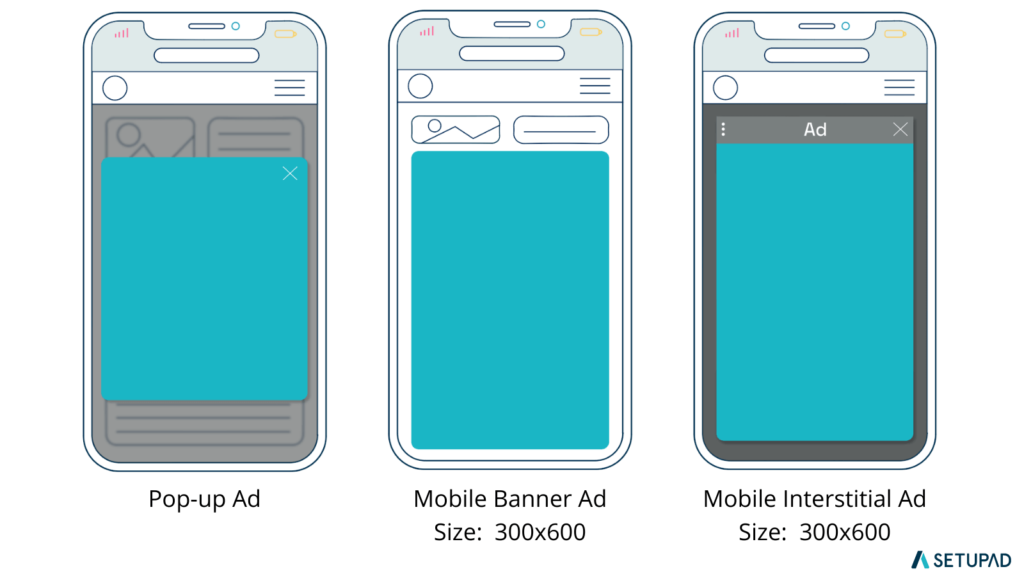
Interstitials were more common in mobile and app environments (both iOS and Android). However, as of November 2020, interstitial ad format is also used for desktops. After implementing this ad format, our client saw a 42% ad revenue increase.
How much do interstitial ads pay?
Interstitial ads have one of the highest CPM prices compared to other ad formats like banner ads. Latest 2024 data suggests that while the United States consistently offers the highest eCPMs for both platforms, iOS generally outperforms Android across most regions.
For iOS, the United States stands out as the most lucrative market with an eCPM of $12.81, followed by Taiwan at $9.26 and Australia at $8.93. The United Kingdom also performs well, with an eCPM of $8.36.
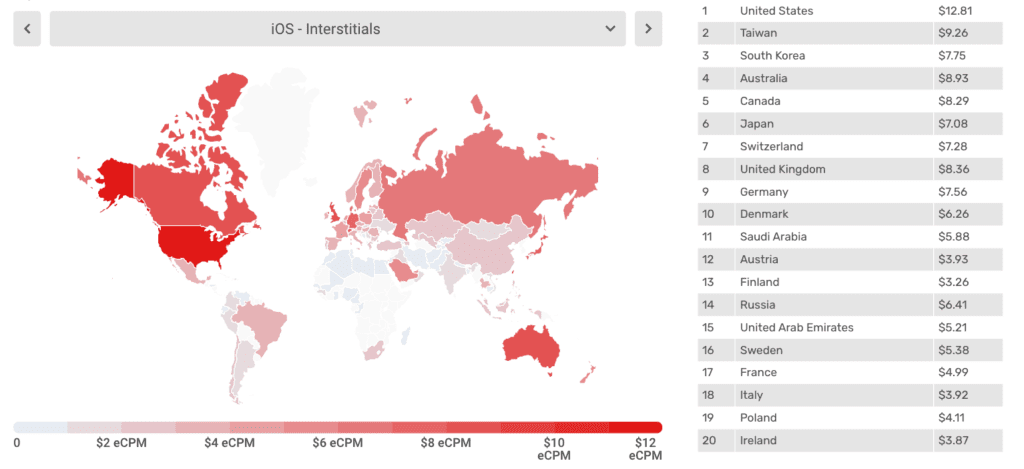
Source: Appodeal
Similarly, for Android, the United States remains the top market with an eCPM of $12.13, although this is slightly lower than the eCPM for iOS in the same country. South Korea ($8.21) and Australia ($8.05) are also strong markets for Android interstitial ads.
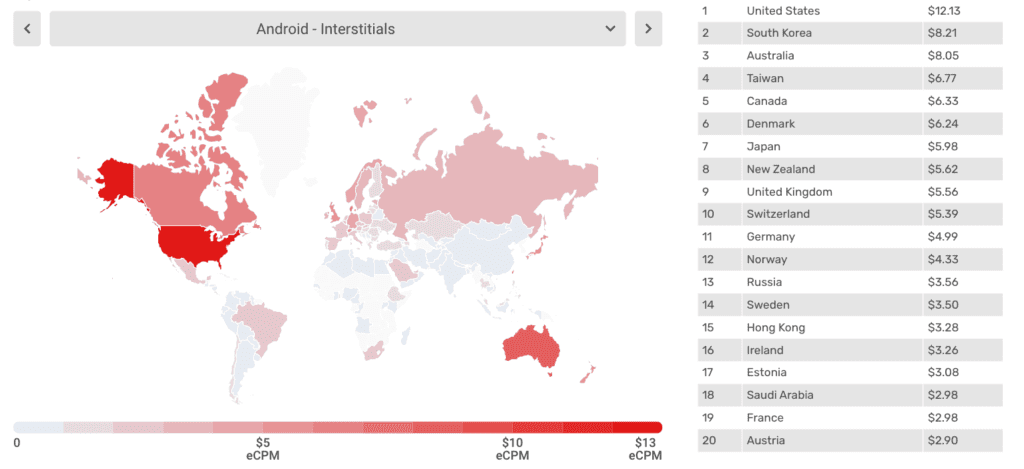
Interstitial Ad Penalties
Google penalizes websites that use intrusive interstitial ads, which negatively impact user experience, particularly on mobile devices. These penalties are designed to ensure that users can access content easily without being hindered by ads that cover the main content or disrupt the flow of their navigation.
Google targets specific types of intrusive interstitials:
- Popups that cover the main content immediately after the user navigates to a page.
- Standalone interstitials that must be dismissed before accessing the main content.
- Interstitials that are served at every user break.
- Layouts where the above-the-fold content is obscured by the interstitial, making the main content accessible only after scrolling.
Websites penalized for intrusive interstitials can see significant drops in their search rankings. This can lead to decreased traffic and visibility, which is why it’s critical for publishers to comply with Google’s guidelines.
Interstitial Ad Penalty Exceptions
Some interstitials are exempt from penalties if used correctly:
- Legal obligations such as cookie usage notifications or age verification. Interstitials required by law, such as those for cookie consent (in compliance with GDPR) or age verification, are exempt from penalties. These are necessary to ensure legal compliance and user protection.
- Interstitials that appear on pages not publicly indexable by Google, such as login dialogs or paywall content, are also exempt. This is because these pages are not part of Google’s search index and require user authentication or payment to access.
- Banners that use a reasonable amount of screen space and are easily dismissible.
These exceptions ensure that essential interstitials can be used without negatively impacting a website’s search rankings, as long as they are implemented correctly.
Interstitial Ads Example
Interstitial ads appear at natural transition points in an app or website. These ads can take various forms (e.g., text, image, rich media, video, and playable) and are typically used across different devices, such as mobile apps, mobile websites, and desktop websites.
Interstitial ad units that don’t include video should have an immediate option to close the ad. Whereas interstitial video ads may have up to a 5-second delay before a user can close the ad.
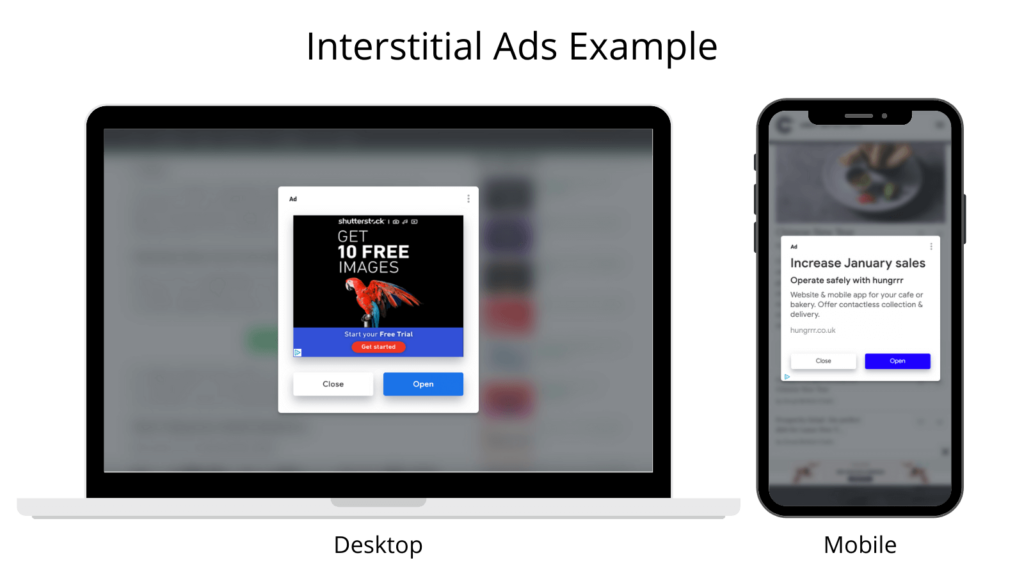
Note: You can check out our quick video, which features examples of interstitial ads in action, to gain a clearer understanding of how they work!
Text interstitial ads
Text interstitial ads are simple yet effective, often featuring a headline, brief description, and a clear CTA. These ads are ideal for direct response campaigns.
- For example, a publisher might use a text interstitial to prompt users to sign up for a newsletter or take advantage of a limited-time offer.
Image and rich media interstitial ads
Image and rich media interstitial ads use visuals to capture attention, ranging from static images to interactive graphics.
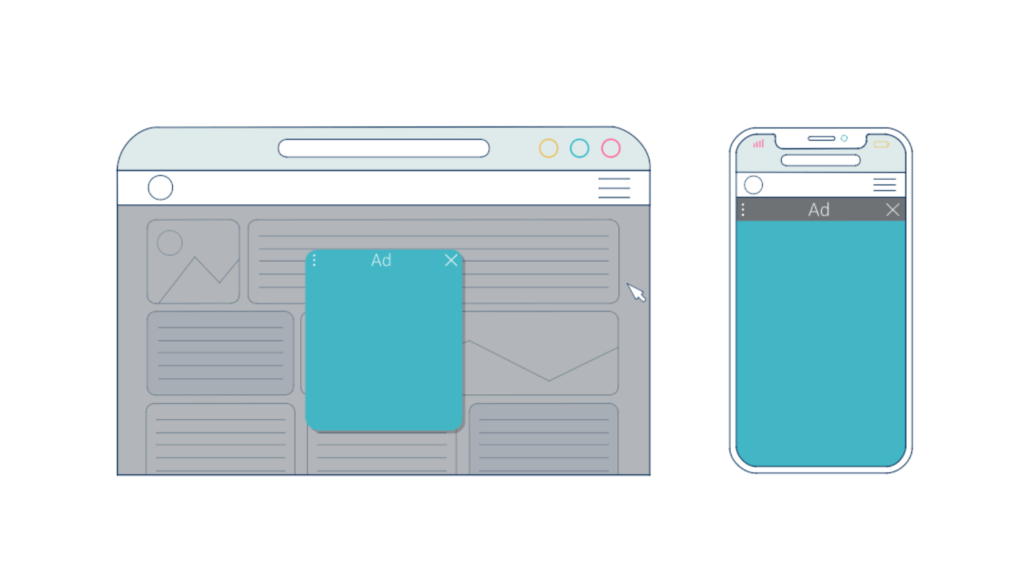
An image interstitial can showcase a new product launch with vibrant, branded visuals, encouraging users to explore further. Rich media interstitials, which might include animations or interactive elements, offer even deeper engagement.
Video Interstitials
Video Interstitials are often used for brand storytelling or product demonstrations. For example, a publisher might use a video interstitial to show a 15-second product demo, highlighting key features and benefits, before users proceed to their next activity.
Playable Interstitials
Playable Interstitials allow users to interact directly with the ad, making them particularly effective for gaming apps. A typical example would be a mini-game ad where users can try out a snippet of gameplay before deciding to download the full app, driving higher engagement and conversions.

How Do Interstitial Ads Work?
Firstly, a user lands on your website or app, and a request for an interstitial ad is sent to the publisher’s ad exchange (for example, Google AdX). Interstitial ad size will depend on the creative chosen during the real-time bidding auction as well as the size of the device. An ad exchange will detect the device’s screen size and send the ad request with these dimensions to the advertisers.
Note: The advertisers can respond with any size creative as long as it fits within 50% of the screen width and 40% of the screen height.
The highest bidder’s creative will be returned, and the interstitial ad will get displayed on your website.
To make it a bit more clear, here’s a concise 5 step explanation of how interstitial ads work:
- Interstitial ads are triggered at natural transition points in an app or website, like between game levels or when moving between pages.
- The ad takes over the entire screen, grabbing the user’s full attention. This can include text, images, videos, or interactive content.
- Users can interact with the ad by clicking or engaging with its content, often leading to a landing page or app store.
- Most ads offer a close button, with timing depending on the ad type (e.g., static ads can usually be closed immediately, while video ads may have a short delay).
- To avoid user frustration, the ad’s display frequency is limited, ensuring it doesn’t appear too often to the same user.
Why Use Interstitials?
- Ad Diversity: By integrating interstitial ads, publishers can increase their overall websites’ ad diversity, thus minimizing “banner blindness.”
- High Ad Revenue: Interstitials ads have higher CPMs and CTRs (click-through rates) than standard banner ads, which increases publishers’ overall ad revenue.
- Better Ad Engagement: Thanks to their large size, interactiveness, and animated content, interstitial ads are ideal for creating an engaging ad experience for users.
- High Demand: Interstitial ads are one of the most popular ad formats in the programmatic advertising industry, with demand from all major DSPs like Xandr and Google Display & Video 360 and ad platforms like Google Ads and AdMob.
Frequency Capping For Interstitial Ads
As mentioned, Google sets frequency capping of 1 interstitial ad displayed in an hour for 1 unique user by default. This is done to preserve the user experience and limit the number of times an interstitial ad will appear in front of the same user.
7 Interstitial Ads Best Practices
Here are the 7 best practices for an effective use of interstitial ads:
- Don’t overcrowd your website with too many ads–it can lead to a negative user experience, which in turn will affect your traffic and increase bounce rate.
- Make sure interstitials have a close button from the start. The close button should appear either immediately or after 5 seconds for video interstitials.
- Avoid working with multiple Google accounts, because there is a possibility that interstitials will be displayed more than allowed.
- Avoid custom templates–you shouldn’t change the frequency capping set by Google.
- Consider the natural flow of user engagement when implementing interstitial ads. They shouldn’t obstruct your mobile site or app usage.
- Regularly conduct A/B testing to determine the most effective ad placement. Position ads at natural user breaks rather than interrupting key interactions.
- Show interstitial ads during transitions or natural breaks in user activity. Introducing a short delay before displaying the ad can reduce accidental clicks, particularly in apps with frequent interactions.
- Avoid showing interstitial ads too frequently to prevent user frustration and maintain engagement levels.
Conclusion
Setupad provides interstitial ad formats along with many others. We suggest using interstitial ads for your mobile site and website because they enable high-value impression delivery and help to increase your ad revenue. Follow the tips mentioned above, and you will achieve the best result with this ad format.
If you want to try interstitials on your site, click the button below or email at [email protected], and we’ll get in touch with you!
Frequently Asked Questions (FAQs)
What are interstitial ads, and how do they work?
Interstitial ads are full-screen ads that appear during natural transitions in an app or website, such as between levels in a game or between pages on a site. They take over the entire screen, capturing the user’s attention before they can proceed to the next step.
How can I ensure my interstitial ads are not intrusive?
To avoid being intrusive, display interstitial ads at natural breakpoints in the user flow, provide an easy-to-find close button, and limit the frequency of ad displays. Ensure ads are relevant to the user’s activity and avoid interrupting critical tasks.
What are the best practices for designing interstitial ads?
Design interstitial ads with clear, compelling calls to action, make them visually appealing but not overwhelming, and ensure they load quickly. Respect the user experience by placing ads strategically and allowing for easy dismissal.
How can I measure the effectiveness of my interstitial ad campaigns?
Measure effectiveness using key metrics such as click-through rates (CTR), conversion rates, and user engagement. Use A/B testing to compare different ad placements and designs, and analyze user behavior after interaction with the ads.
Are interstitial ads suitable for all types of websites and apps?
Interstitial ads are most effective in apps and websites where natural breaks in content occur, like games or news apps. However, they may not be suitable for all sites, particularly those with continuous content flows, as they can disrupt the user experience.


